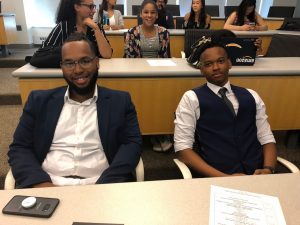On July 31, 2018, our first cohort of REU POWER https://stem.northeastern.edu/summer/reu/ participants had the opportunity to present on their research work.
Research Experience for Undergraduates
Poster Session and Presentations 2018
[ 1] Smart Solar EnergyMichaela Harrell, Clark Atlanta University Brad Lehman, Professor, Electrical and Computer Engineering
Mahshid Amirabadi, Assistant Professor, Electrical and Computer Engineering
Abstract: Solar photovoltaic (PV) installations traditionally are stand-alone systems without integrated computation. However, it is possible to utilize real-time processes to adaptively reconfigure solar PV installations while sensing and computing the environmental factors. This research will design and build new types of solar installations that can adapt their performance depending on their environmental conditions. For example, a smart PV installation will include power converters and microprocessors within each panel that enable the solar panels to self-heal and self- optimize to produce higher power. New types of inverters for photovoltaic applications are included that use intermediate voltages on capacitors to have controllable fluctuations on them so that the capacitances can be substantially reduced. Combined with fast switching pulse-width-modulators the goal is to reduce the cost, volume and weight of the entire PV system by up to 50%. Sensor information, weather patterns, and high-performance computational algorithms running machine learning algorithms can rely on statistical analysis with massive amounts of data to predict PV power in large geographical regions. The utility and Independent System Operators can then predict the power produced in regions to better match overall power generations with the needed loads. This information is vital for the future of smart grid operation.
[ 2] Synchronized Phasors and Big Data in Smart Grid Power System
Gustaf Njei, MassBay Community College
Ali Abur, Professor, Electrical and Computer Engineering
Abstract: North American power grid includes multiple Regional Transmission Organizations (RTOs) or Independent System Operators (ISOs) which coordinate, control and monitor the operation of the entire grid. Coordination of these complex and large volumes of power exchanges while maintaining the system security and reliability presents a new and major challenge to the operators of power grids. Traditionally, state estimators (SE) perform real-time monitoring of the entire system state based on the available measurements and network model to help monitor the safety of the grid using the supervisory control and data acquisition (SCADA) system. However, in the past two decades, new metering devices that are referred to as the phasor measurement units (PMU) have been introduced. These devices can provide measurements at high data acquisition rate and more importantly, use global positioning system (GPS) satellites to synchronize the measurements. This research develops improved state estimation functions for the power grid, and also emphasizes the insertion of renewable energy generation such as solar and wind. Advanced power system simulation tools are used to verify the robustness and feasibility of the grid, particularly in contingency cases, such as when there is lost generation or bad data.
[ 3] Photosynthetic Efficiency for Biomass and Biofuel
Jessica Figueroa, Northern Essex Community College
Carolyn Lee Parsons, Associate Professor, Chemistry and Chemical Biology
Abstract: Depletion of fossil fuel reserves and climate change attributed to greenhouse gases are imminent challenges facing our planet. To address both of these global challenges, the research focuses on engineering microalgae and plants for increased biomass production that can be harnessed for biofuel applications. One approach involves improving the efficiency of photosynthesis by improving the enzymes (i.e. reducing photorespiration) in the Calvin Cycle to enhance carbon fixation and its conversion to sugars through photosynthesis. Instead of focusing at the enzymatic level, this research project focuses on altering plant development to yield more leaves by which light capture, carbon fixation, and conversion to sugars can occur. In particular, this project involves characterizing the effect of several transcription factors that control plant development and ultimately their ability to capture energy through photosynthesis
[ 4] A Hybrid Systems Framework for Human-in-the-Loop Control of HVAC Systems
Christian Hardy, MassBay Community College
Michael Kane, Associate Professor, Civil and Environmental Engineering
Abstract: Building occupants, building physics, HVAC systems, and controls make up a complex dynamical system with continuous and discrete states and interactions, i.e. a hybrid dynamical system. Traditionally, occupant physics and behavior are abstracted from the building engineering through simple room temperature set-points. At most, the interaction between the two systems is captured by changing setpoints based on occupancy. This abstraction neglects the autonomy of users to change setpoints and create over-rides that often forfeit the savings that the control system aimed to achieve. As users increasingly interact with home energy IoT devices, this shared autonomy will grow in significance. This research aims to leverage these interactions to build classes of hybrid-dynamical models of user behavior. Such models will be implemented in model-based estimators of the noisy channel between user desire and the control system reference. This data-driven approach will utilize datasets from thousands of occupants from Pecan Street and Ecobee.
[ 5] Tunable Inductors for Adaptive Power Electronics
Aaron Essex, Hampton University/Northeastern University Nian Sun, Professor, Electrical and Computer Engineering
Abstract: Because portable devices are on-the-move and in unknown environmental conditions, it is necessary to operate the power management devices in wide ranges of operating conditions. This research proposes to investigate novel compact and power efficient adaptive power electronics with voltage-tunable magnetoelectric inductors. This is possible by building magnetoelectric magnetic/ferroelectric heterostructures, which allows for voltage control of magnetic permeability and therefore, voltage tunable inductors which are solenoid inductors with a magnetic/ferroelectric heterostructure core. The research will develop these devices and then utilize them in adaptive power supplies to improve the low efficiency of power electronics at low loads, such as in the idle states of smartphones, laptops, etc.
[ 6] Nanomaterials for Energy
Zandria Hughes, Clark Atlanta University Jahsiah Sanders, Clark Atlanta University
Marilyn Minus, Associate Professor, Mechanical and Industrial Engineering
Abstract: This research area is of relative interest in terms of its focus on lightweight materials formed from polymer-based nano-composite materials with well-controlled structural morphology, for applications such as wind turbine blades, lightweight airplanes, etc. Nano-materials have been studied quite extensively in composites due to their impressive properties and opportunity to provide information regarding nano-scale phenomena and control of materials processing at this level. Typical composites exhibit average properties associated with components A (i.e., matrix) and B (i.e., filler). For a nano-composite, B is able to affect A locally (at the nano-scale) and this can subsequently dictate macroscopic properties. REU research projects s research will contribute to experimental pathways to build designer material. In other words, identify the materials: (i) desired properties, (ii) necessary architecture/morphology to exhibit said properties, and (iii) specific processing methods to achieve the desired material morphology and properties.
[ 7] Development and Characterization of An Active Back Brace With Embedded Sensors
Katiso Mabulu, Hampton University/Northeastern University
Samuel Felton, Assistant Professor, Mechanical and Industrial Engineering
Abstract: According to the Federal Bureau of Labor Statistics, the back injuries of more than 1 million workers account for nearly 20% of all injuries and illnesses in the workplace.It has been proven that maintaining proper posture throughout the day can reduce work-related back injuries. However, the major drawback of most postural back braces is the discomfort of wearing them for long periods of time, this leads users to incorrectly adjust the brace prioritizing comfort over function and leading to continued back injuries.The purpose of this project is to develop variable-stiffness elements for a postural back brace that will be comfortable and functional for long periods of usage to help reduce work-related back injuries.




